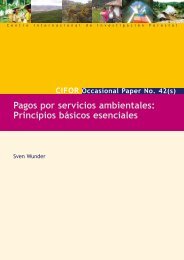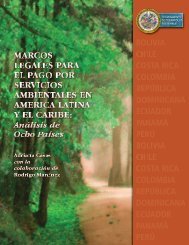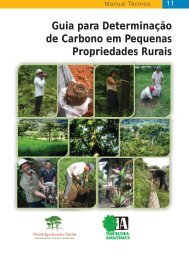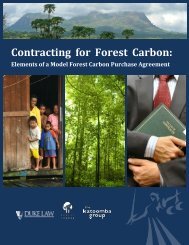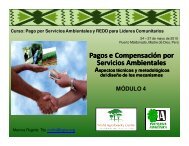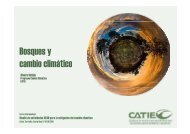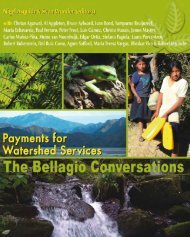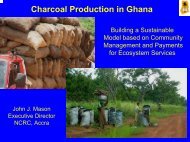Guide on Climate Change and Indigenous Peoples
Guide on Climate Change and Indigenous Peoples
Guide on Climate Change and Indigenous Peoples
- No tags were found...
You also want an ePaper? Increase the reach of your titles
YUMPU automatically turns print PDFs into web optimized ePapers that Google loves.
is to ensure that indigenous peoples’ rights to their forests <strong>and</strong> forestresources (including carb<strong>on</strong>) are recognized <strong>and</strong> respected. This is anopportunity to strengthen the capacities of the indigenous organizati<strong>on</strong>s<strong>and</strong> communities to pursue, further, this goal. It is also the right time topush for the rectificati<strong>on</strong> of the wr<strong>on</strong>gs <strong>and</strong> injustices d<strong>on</strong>e against themin the name of forest c<strong>on</strong>servati<strong>on</strong> or “sustainable forest management.”• Opportunity to strengthen traditi<strong>on</strong>al livelihoods <strong>and</strong> generateadditi<strong>on</strong>al resources from alternative livelihoods which are forestrelatedor not. Other potential benefits from REDD include: direct payments based <strong>on</strong> the maintenance of intact forest, otherecosystem services <strong>and</strong> quantity of CO2 emissi<strong>on</strong>s reduced or keptin the ground; pursuit <strong>and</strong> enhancement of traditi<strong>on</strong>al natural resourcemanagement practices; c<strong>on</strong>tinued use of the forest for traditi<strong>on</strong>al livelihoods <strong>and</strong> othercultural values. REDD does not preclude the use of the forest forother activities like ecotourism; REDD activities operate over a l<strong>on</strong>g time scale, <strong>and</strong> the benefits havethe potential to be c<strong>on</strong>tinuous for decades.• Awareness raising <strong>on</strong> indigenous peoples sustainable resourcemanagement systems. The debate <strong>on</strong> REDD is also a chance to educategovernment <strong>and</strong> the broader society <strong>on</strong> how indigenous peoplesmanaged to save the forests in their territories <strong>and</strong>, therefore, theirknowledge <strong>and</strong> forestmanagement systems shouldbe protected <strong>and</strong> enhanced.The work by indigenouspeoples in Ind<strong>on</strong>esia,through AMAN, is a goodexample of what indigenouspeoples can do to maketheir issues more visible <strong>and</strong>to get the needed resp<strong>on</strong>sesfrom government <strong>and</strong> theinternati<strong>on</strong>al community.(See p. 82) This exampleis a model which otherindigenous peoples canfollow.• Further implementati<strong>on</strong> ofthe UNDRIP. If designed properly,REDD+ can helpPART V: REDD/REDD+ <strong>and</strong> <strong>Indigenous</strong> <strong>Peoples</strong> 79



